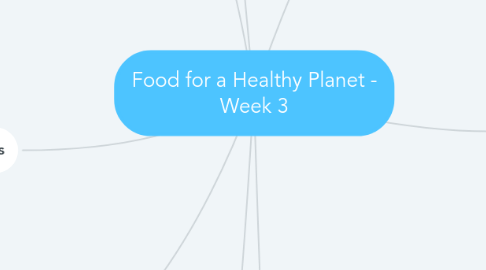
1. Whole foods, diversity and convenience
1.1. Chemical Composition
1.1.1. Slow digestion
1.1.1.1. Greater satiety
1.1.1.2. Reduces insulin response
1.1.1.3. Slower and less lipid uptake
1.1.1.4. Greater fermentation
1.1.2. Different effects
1.1.2.1. Juice vs, eating fruit and vege - not just whats in it but what is physically there.
1.2. Whole foods vs. Refine and recombine
1.2.1. Traditional vs. recently introduced
1.2.2. slow vs. rapid digestion
1.2.3. Molecular diversity vs. Similiarity
1.2.4. Food structure complexity vs. simplicity
2. Healthy consumption of foods
2.1. Healthy lifestyles from Diet x Lifestyle x genetics
2.1.1. Epidemiology - People asked to record what they eat over time and there health at the time
2.1.2. Nutritional value derives from food structure.
2.2. Healthy Living Pyramid
2.3. Integration of meal/food/ingredient effects
2.3.1. Some ingredients have health benefits on their own, most is modulated by the food 'delivery' systems and meals
2.3.2. Some food take 24-48hrs to be fully digested
2.3.3. How has the digestive system evolved
3. Public health advice about food consumption
3.1. Maintaining a calorie balance
3.2. Eating nutrient dense foods
3.3. Nutrients should be from wholesome food
3.4. BASICALLY: eat food, Not too much, mostly plants
3.5. Underlying Mechanisms
3.5.1. Satiation (fullness via eating) per calorie
3.5.2. Food physical structure as well as composition
3.5.3. Dietary guidelines based on epidemiology
3.5.4. Guidelines may need to be based on molecular composition, food structure, multiple in-body effects
4. Fast Food and Slow Foods
4.1. Slow Foods
4.1.1. Prep time required
4.1.2. Slowly digested
4.2. Fast Foods
4.2.1. Available on demand
4.2.2. Rapidly digested
4.2.3. High fat, salt and sugar = keep fresh for longer
4.2.4. Fast digestion can contribute to diabetes, cardiovascular disease
5. Revolution in processed foods
5.1. More of
5.1.1. Increase in whole grains
5.1.2. Greater use of fruits and veggies
5.2. Less of
5.2.1. Reduced fat, salt, sugar contents
6. Evolution of our diet
6.1. Since the beginning of agriculture, we have adapted as humans
6.2. Pre agricultural diet
6.2.1. Vegies
6.2.2. Fruit
6.2.3. Protein
6.2.4. WHY/ Hunter gatherer processes
6.3. Post agricultural diet
6.3.1. Grains
6.3.2. Vegies
6.3.3. Fruit
6.3.4. Protein
6.3.5. Dairy
6.3.6. Fats, oils
6.3.7. WHY?? We began keeping animals which meant more protein and dairy. Before we did not drink cows milk (new). Refining process also begun (fabricated foods)
6.4. Industrial Food diet
6.4.1. Explosion in fats, sugars and salts
6.4.2. Same as post agriculture otherwise
6.5. Consequential intakes
6.5.1. We are hard wired to want fats, sugars and salts - tastes are what we crave. When we were in a food deficient environment we needed these. People who got those evolved and were sucessful
6.5.1.1. Fats = lipids we need for membranes
6.5.1.2. Sugar = carbohydrates we need for energy
6.5.1.3. Salt = Protein
6.5.2. Evolutionary Collision of our ancient genome with the nutritional qualities of recently introduced foods may underlie many of the chronic diseases of western civilisation
6.6. Extensive cooking and processing of our food
6.6.1. Rapid and extensive energy delivery
7. Human digestive tract
7.1. Mouth
7.1.1. Start processes of solid foods, tasting things if we don't like we can spit out.
7.2. Stomach
7.2.1. Food sits in stomach
7.2.2. Bitter taste receptors- evolution (poison are bitter) - if we dont like we can vomit it back
7.3. Small intestine
7.3.1. Serious digestion - secretion of enzymes (breakdown of lipids, proteins and carbohydrates) breakdown of fatty acids and glucose, etc,
7.3.2. 2 or 3m wrapped up inside us
7.3.3. Lined with villi -large surface area, well set up to absorb a lot, in the past it was difficult to digest
7.4. Hormonal signals - Satiety signals
7.4.1. Transfer from small intestine to brain saying that it doesn't need anymore food
7.4.2. Foods that stimulate this is porridge and veggies
7.5. Large intestine
7.5.1. All plants structural material passes lareg intestine
7.5.2. Commonly dietary fibre
7.5.3. Interest in microbes population
7.5.3.1. Higher microbial diversity = non obesity

